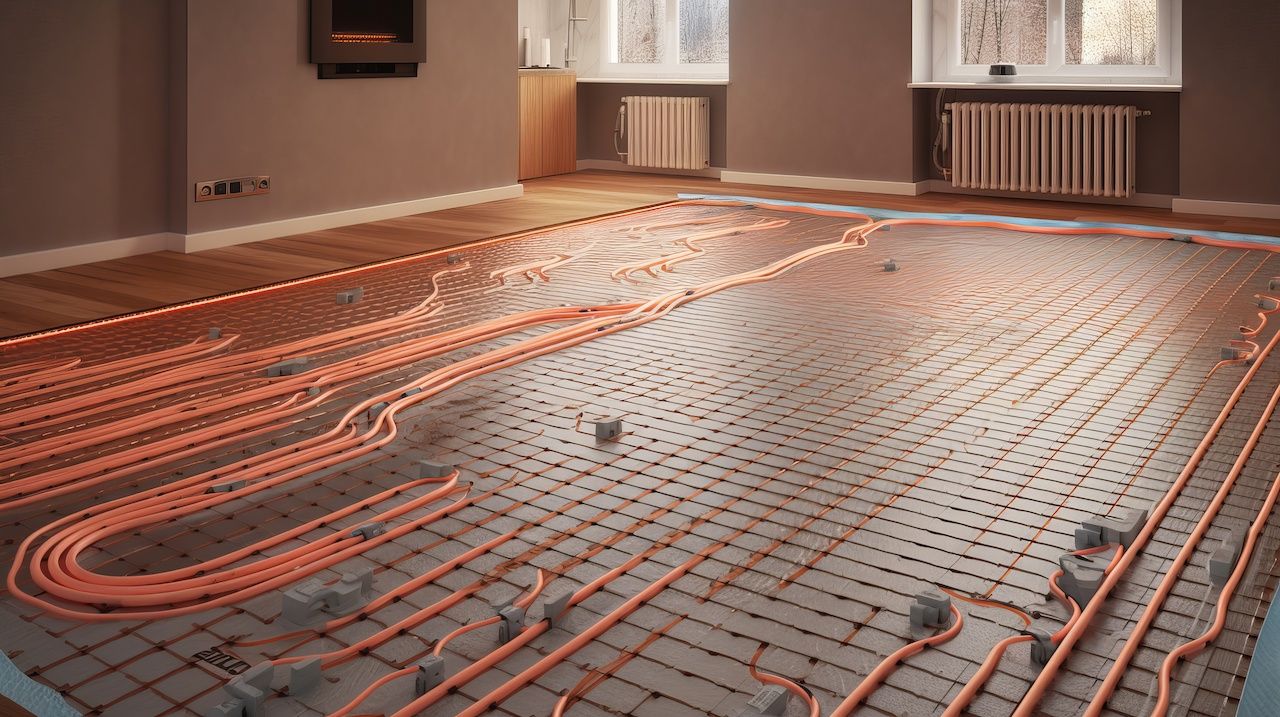
Imagine stepping onto a tile floor in the dead of winter and feeling a warm embrace envelope your feet. That's the magic of radiant heat. Unlike the dry, warm air emitted by traditional forced air systems, radiant heating provides a gentle and even warmth, starting from the ground up. At the forefront of this innovative technology is radiant floor heating. As homeowners increasingly seek energy-efficient methods to heat their living spaces, radiant floor heating systems are capturing attention. Unlike the conspicuous vents and noisy operations of other systems, radiant heating remains unobtrusive, delivering heat directly from the floor. Let's delve deeper into the world of radiant heating and understand why it's revolutionizing home heating solutions. Whether you're considering a heating solution for a single room or your entire home, this guide sets the stage for you to discover the unparalleled comfort of radiant floor warmth.
Join our newsletter
Stay on top of the latest in landscaping and lawn care with one valuable tip right in your inbox every Saturday morning.
Dive into Radiant Heat: More Than Just Warmth
At its core, radiant heat operates on a simple principle: transfer of heat directly to people and objects in a room. Unlike forced air heating, which circulates warm air, radiant heating warms the floor or panels, turning them into heat emitters. This results in a significant thermal mass, distributing heat more evenly and efficiently.
Here are some standout benefits of radiant heat:
- Consistent Warmth: Unlike conventional heating systems that can produce cold spots, radiant heat offers consistent warmth across a room.
- Silent Operation: Say goodbye to the noisy start-ups and shutdowns of traditional systems. Radiant heating operates silently, adding to your home's tranquility.
- Improved Air Quality: With no need to circulate air, there's a reduced movement of dust and allergens, leading to cleaner indoor air.
- Energy Efficiency: Due to its direct heating method, radiant heat tends to be more energy efficient, reducing those monthly energy bills.
As you'll see, radiant heat isn't just about warmth. It's about elevating the comfort and health of your living space.

Types of Radiant Floor Heating: Electric vs. Hydronic
When considering radiant floor heating, two primary systems emerge: electric and hydronic. Each comes with its unique benefits and considerations, tailored to different needs and preferences.
Electric Radiant Floor Heating
Electric radiant floor heating systems utilize thin heating cables, often incorporated into mats, to deliver warmth. These systems are particularly suited for:
- Single room applications, like bathrooms or kitchens.
- Existing home renovations where installing tubing might be more challenging.
- Regions with cheaper electricity rates.
Benefits:
- Easier and quicker to install than hydronic systems.
- Doesn't require a boiler or water heater.

Hydronic Radiant Floor Systems
Hydronic radiant floor systems are the most popular and efficient form of radiant heating. They use heated water circulated through tubing laid beneath the floor. Key characteristics include:
- Ideal for whole-house heating or new constructions.
- Operates at lower temperatures than electric systems, making it more energy-efficient in the long run.
- Relies on a boiler system or water heater to heat the water.
Comparison:
- Installation Cost: While electric systems might have a lower upfront cost, hydronic systems often offer better long-term value due to their efficiency.
- Operational Cost: Electric systems might have higher operational costs, especially in areas with high electricity rates. Hydronic systems, using hot water, can be more economical.
- Efficiency: Hydronic systems tend to be more energy efficient because they utilize warm water, ensuring consistent heat distribution.
Whether you lean towards electric or hydronic, it's essential to consider your home's requirements, budget, and long-term goals before deciding.
Radiant Heating System vs. Traditional Heating Methods
In the realm of home comfort, the radiant heating system has been turning heads and warming toes. But what sets it apart from traditional methods?
How Radiant Heating Systems Shine
Radiant heating systems, particularly radiant floor heating, work by directly heating the floor or objects in a room, as opposed to the air. This results in:
- Even distribution of heat throughout the room without cold spots.
- More efficient use of energy, leading to reduced energy bills.
- Improved air quality since it doesn’t circulate allergens like some forced air systems.
The Drawbacks of Traditional Heating
Traditional methods, especially forced air heating, face limitations:
- They heat by circulating warm air, which can lead to uneven temperatures and cold drafts.
- Such systems can introduce dust and allergens into the air, potentially affecting indoor air quality.
- Forced air systems often require a separate air conditioning system for cooling, whereas radiant systems can sometimes be integrated with cooling solutions.
In conclusion, while traditional methods have their merits, the comfort, energy efficiency, and enhanced air quality offered by radiant systems make them a compelling choice for many homeowners.
Essential Components of Radiant Floor Heating Systems
Radiant floor heating systems are more than just a luxury; they're an engineering marvel. Let's break down the key components that make these systems so effective.
Foundational Elements
At its core, a radiant floor heating system operates by circulating heated water or electricity through tubing laid beneath the floor. These are the essential components:
- Radiant floor tubing: This is where the magic happens. The tubes transfer the heat to the floor above, ensuring an even spread of warmth.
- Heat source: Depending on the type of system, this could be electric radiant elements or a boiler system providing hot water.
Join our newsletter
Stay ahead of the curve in all things outdoor.
Get the inside scoop on the latest landscaping, lawn care, and fencing trends with 1 actionable tip every Saturday morning.
Role of Boilers and Water Heaters
For hydronic radiant floor systems that use water:
- Boiler or water heater: This is responsible for heating the water before it circulates through the tubing. Modern water heaters are designed to be energy-efficient and cost-effective.
- Pumps: Once the water heater or boiler heats the water, pumps ensure that the heated water is circulated effectively throughout the radiant floor tubing.
Electrical Input
For electric radiant floor heating:
- Electrical input: An important component where electricity heats the floor directly. Systems might also use further electrical input like thermostats for precise temperature control.
Installation Insights
The installation process involves laying the tubing or electric mats, connecting them to the heat source, and then covering with an effective floor covering. For best results, it’s crucial to choose a finished floor material that conducts and retains heat well.

Radiant Heating: The Pinnacle of Energy Efficiency
The modern home seeks not only comfort but also sustainability. Radiant heating is at the forefront of this shift, championing both warmth and energy efficiency.
Green Home & Reduced Energy Bills
Radiant heating systems are a boon for eco-conscious homeowners. Here's how they make a difference:
- Energy efficient: Unlike traditional systems, radiant heat directly warms surfaces and people, meaning no energy is wasted in heating unused air.
- Lower energy bills: Given the efficiency of these systems, homeowners often see a reduction in their energy bills. The warmth is felt more directly, allowing thermostats to be set at lower temperatures, which further cuts costs.
- Solar compatibility: Some radiant systems can even be paired with solar heat, harnessing the power of the sun for an even greener approach.
The Future of Heating: Sustainable Living
As the world gravitates towards sustainable solutions, radiant heating is a standout. Its seamless integration with renewable sources and its energy efficiency make it a top choice for those aiming for a sustainable living space. As the cost of energy continues to rise, investing in a radiant heating system today might just be the cost-effective solution homeowners are seeking for tomorrow.
Practical Applications: From Room to Home
Radiant floor heating offers homeowners an unparalleled sense of warmth and luxury. Beyond the comfort, its versatility spans from specific room applications to an entire home solution.
Versatility of Radiant Floor Heating
Radiant floor heating systems can be adapted to fit almost any space. Whether you're looking to heat a single room or the whole house, this system has you covered. Bathrooms benefit from heated floors, eliminating the shock of cold tiles, while living areas enjoy an even distribution of heat without the drafts common with forced air systems.

Pros and Cons for Home Applications
- Pros:
- Energy efficient: Consumes less energy than traditional heating systems, reducing energy bills.
- Warm comfort: Offers a consistent warmth across the floor, enhancing overall comfort.
- Aesthetic: No need for bulky radiators or vents, allowing for a cleaner design.
- Cons:
- Installation: The installation process can be more involved, especially in an existing home.
- Cost: Initial cost might be higher compared to other systems, though long-term savings may offset this.
- Floor covering considerations: Some types of floor covering may not be optimal for radiant heat, requiring careful selection.
Embracing radiant floor heating provides not just a comfortable living space, but also an energy efficient approach to home heating.
Why Radiant Floor Heating is the Future
The evolution of home heating solutions has been marked by a continuous search for efficiency, comfort, and sustainability. Radiant floor heating systems perfectly embody these ideals. Offering unparalleled warmth, these systems not only promise comfort but also energy efficiency, positioning them as a clear frontrunner in modern heating solutions. Their adaptability, from individual rooms to entire homes, paired with the ecological advantages, heralds them as the undeniable future of home heating. As homeowners globally recognize the need for sustainable, cost-effective, and comfortable solutions, it's evident that radiant heat doesn't just warm our floors; it warms our future.
Join our newsletter
Stay ahead of the curve in all things outdoor.
Get the inside scoop on the latest landscaping, lawn care, and fencing trends with 1 actionable tip every Saturday morning.